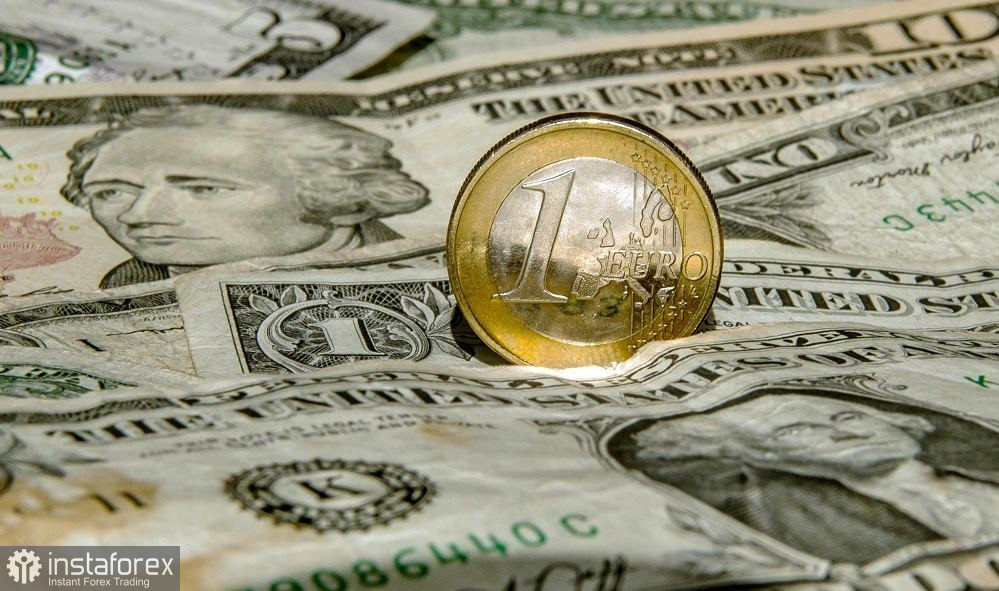With a northern gap, the US dollar index began a new business week. The main cause of this dynamic is the rise in hawkish predictions regarding the Fed's future actions. Before a week ago, the Federal Reserve's next meeting (in May) was more likely to take a wait-and-see stance. Today, traders' assumptions have shifted.
The likelihood that the Federal Reserve will adopt a 25-point scenario next month is currently 61.2%, according to the CME FedWatch Tool. As a result, the likelihood of keeping things as they are is calculated to be 38.8%.
Although the underlying PCE index, which was released last Friday, was in negative territory, the balance moved in favor of a hawkish decision. A distinct situation is related to the shift in market sentiment. The OPEC+ nations announced a further cut in oil production on Sunday, which could potentially trigger a new spike in inflation and tighten the Fed's monetary policy. The dollar was supported by this truth.

In addition, the market has concluded that the Federal Reserve will not be able to finish the current cycle of rate hikes at this time (contrary to circulating rumors), as inflation is still well below its target level. This view has crystallized against the backdrop of the fading banking crisis. Additionally, this information offers the dollar some underlying support. Conversely, however, short positions on the EUR/USD pair continue to appear to be highly risky.
European PCE and inflation
Let me tell you that the most significant inflation releases in the United States and Europe were released on Friday, with repercussions that will be felt for quite some time. European inflation displayed contradictory dynamics: the overall consumer price index, which has been actively declining for five months in a row, came in at around 6.9% with a forecast of 7.1%, while the core index increased once again, this time to 5.7%.
However, contrary to predictions of growth of 4.8%, the primary price index for personal consumption expenditures (PCE) in the US came out at 4.6%. The "main inflation indicator for the Fed" is this indicator, which is the most significant one. Other reports on inflation released in March revealed the same pattern: inflation in the US is cooling (but remains high). This might suggest that the Fed will increase interest rates once more this year, most likely at its May meeting.
I should also point out that another rate increase of 25 basis points is predicted in the Fed's median estimate for this year. Some Federal Reserve officials, including James Bullard in particular, as well as, according to Bloomberg, Jerome Powell himself, cautiously expressed hawkish plans. Journalists claim that he made the pertinent suggestions during a private discussion with congressmen. Hawkish messages tend to sound more confident as talk of the American banking crisis recedes, but all of the Fed members' "hawkishness" is restricted to one and, reportedly, the final 25-point rate increase this year.
The possibility of an early conclusion to the current cycle of PEPP tightening loomed on the horizon despite the hawkish remarks of some Fed members. Since the scales have recently tended to maintain the status quo, the anticipated May rate increase supports the dollar, but this support will only last temporarily, especially in the context of the EUR/USD pair. Since the core consumer price index is still rising in the eurozone, the ECB is being forced to consider retaliatory steps even though inflation is slowly but steadily declining in the United States.
The European regulator's circumstances have gotten worse as a result of Friday's publication. The market is now debating how much rates will rise in the months following the May meeting results, whereas previously it was still uncertain about those prospects. Although a more aggressive scenario cannot be ruled out after the release of February inflation, the baseline scenario anticipates a 25-point increase.
Several experts, including UOB Group, predict that the European Central Bank will raise interest rates by 25 basis points in May and June. Other experts are certain that if the core CPI keeps rising, the European regulator will decide to implement a 50-point raise next month. There is no agreement on the likely results of the upcoming ones; a lot relies on the movement of important inflation indicators. However, given the rise in core inflation in the eurozone, the possibility of slowing down is not generally taken into consideration.
Conclusions
The current information picture, in my view, contributes to the EUR/USD's growth. The general fundamental context is still in favor of the euro, although traders interpreted the underlying PCE index to favor the dollar. Even the Fed's most pessimistic forecast to date predicts one more rate increase—the last one for the year. However, the ECB faces yet another challenge from the eurozone's core inflation rate, which is still rising. It is unclear how the European regulator will handle this problem. The European Central Bank may shortly continue to be the sole "hawk" among the central banks of the major industrialized nations. Everything that has happened so far has gone according to this plan.
The US dollar index rose today as a result of rising oil costs and the possibility of a new surge in inflation. However, the EUR/USD pair is probably going to experience a short-term effect from this fundamental component. Therefore, it is recommended to initiate long positions using southern price movements.
The same can be said about technology. On the D1 timeframe, the price is situated above all of the Ichimoku indicator's lines and between the middle and upper lines of the Bollinger Bands indicator, which has created a bullish "Line Parade" indication. With the main target at 1.0950, this combination suggests that long positions should be prioritized. (the upper line of the Bollinger Bands indicator on the same timeframe).
 English
English 
 Русский
Русский Bahasa Indonesia
Bahasa Indonesia Bahasa Malay
Bahasa Malay ไทย
ไทย Español
Español Deutsch
Deutsch Български
Български Français
Français Tiếng Việt
Tiếng Việt 中文
中文 বাংলা
বাংলা हिन्दी
हिन्दी Čeština
Čeština Українська
Українська Română
Română

